PDO Project Delivery: Quality Management System Code of Practice
VerifiedAdded on 2023/03/23
|39
|12238
|83
Report
AI Summary
This document details a Quality Management System (QMS) Code of Practice designed to ensure consistent quality application in Petroleum Development Oman (PDO) projects. It emphasizes the importance of quality management in mitigating risks and ensuring compliance with requirements throughout the Opportunity Realisation Process (ORP). The document outlines management responsibilities, roles, and the structure of the QMS, including quality planning, resource management, training, and improvement processes. It covers the scaling and application of the QMS, key performance indicators, handling non-conformities, and continuous quality improvement. The appendices provide practical tools such as risk forms, quality activity roadmaps, and checklists to support the implementation of the QMS across all project phases, excluding subsurface activities and post-handover operations.
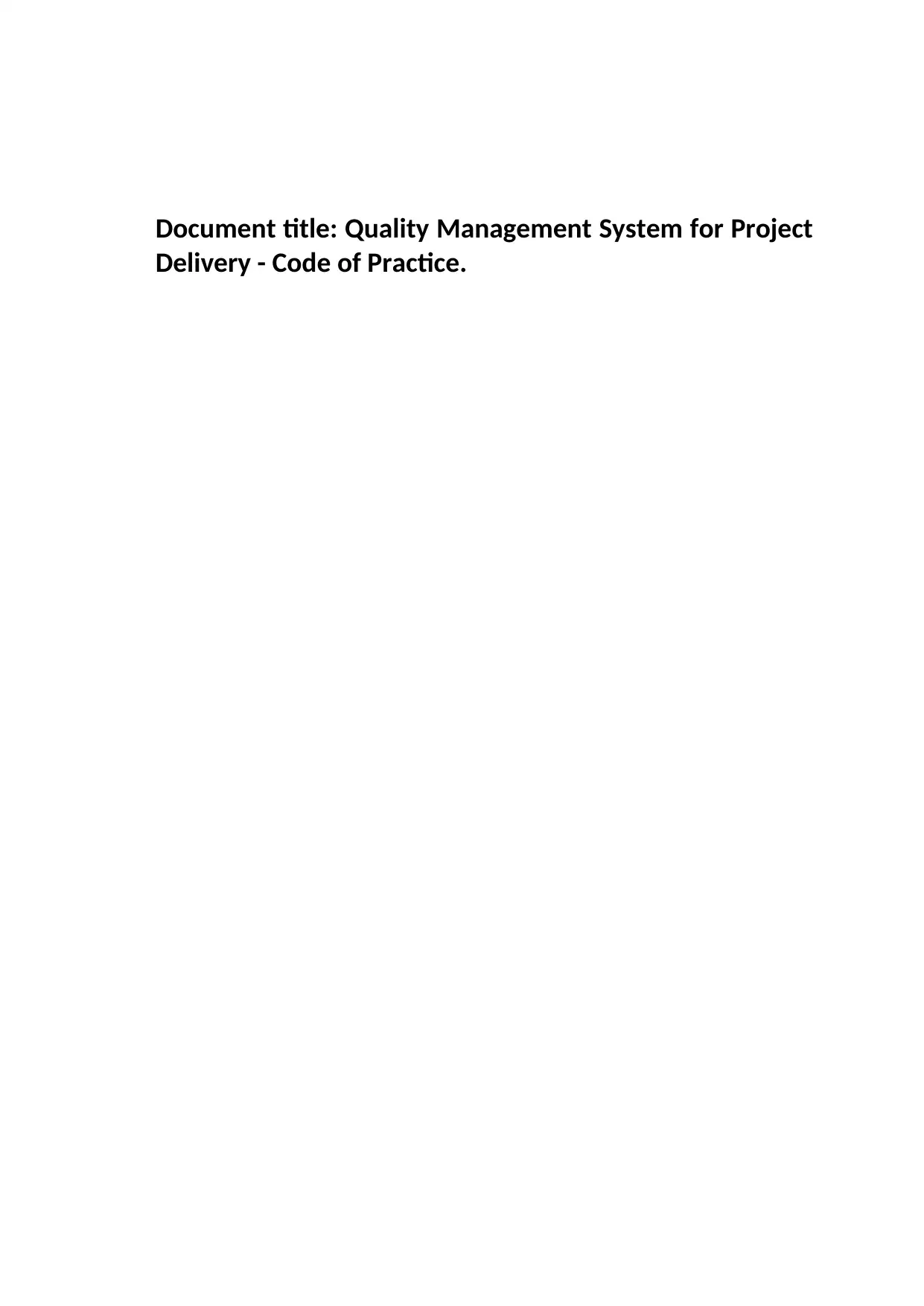
Document title: Quality Management System for Project
Delivery - Code of Practice.
Delivery - Code of Practice.
Paraphrase This Document
Need a fresh take? Get an instant paraphrase of this document with our AI Paraphraser

This page was intentionally left blank
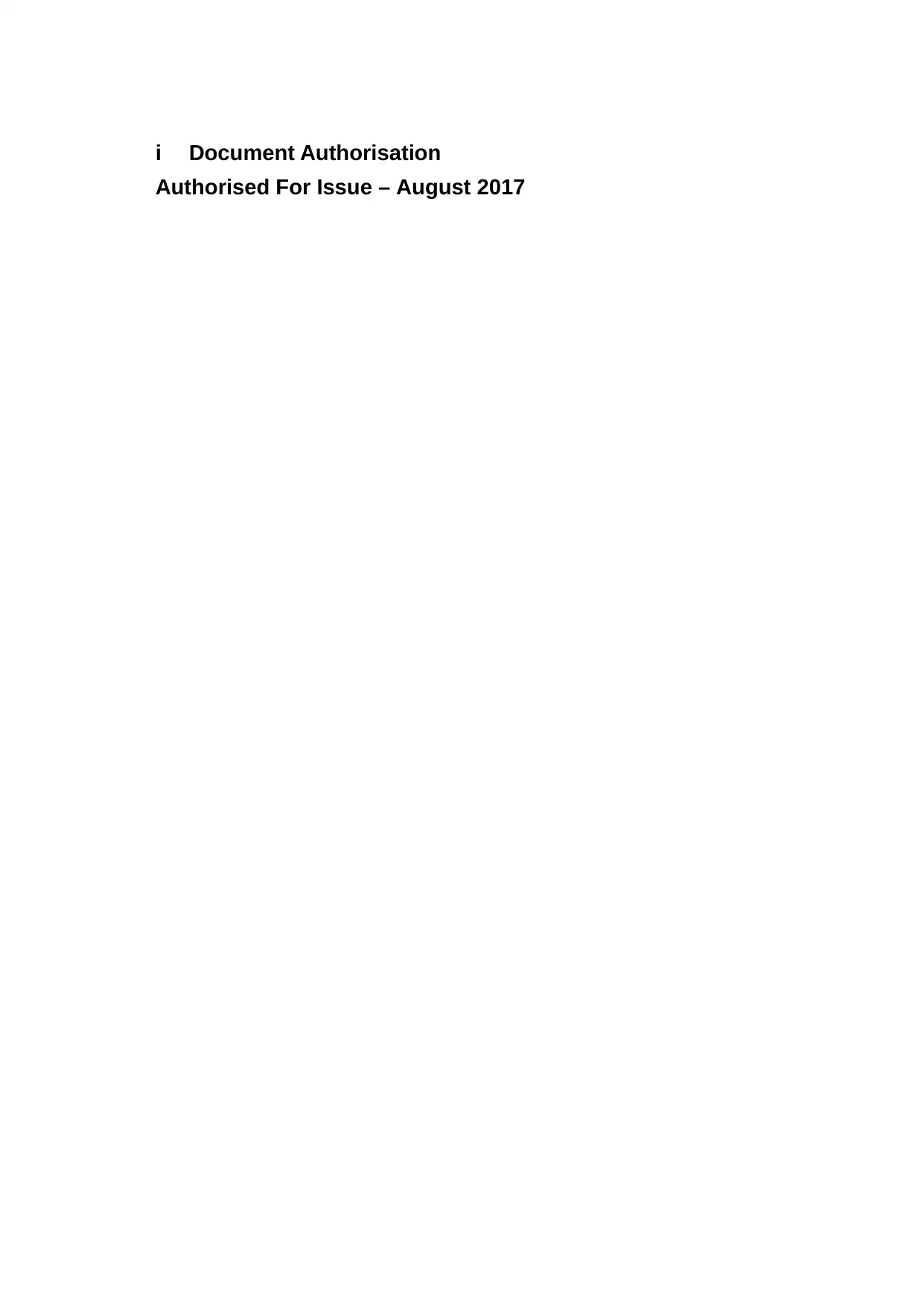
i Document Authorisation
Authorised For Issue – August 2017
Authorised For Issue – August 2017
⊘ This is a preview!⊘
Do you want full access?
Subscribe today to unlock all pages.

Trusted by 1+ million students worldwide
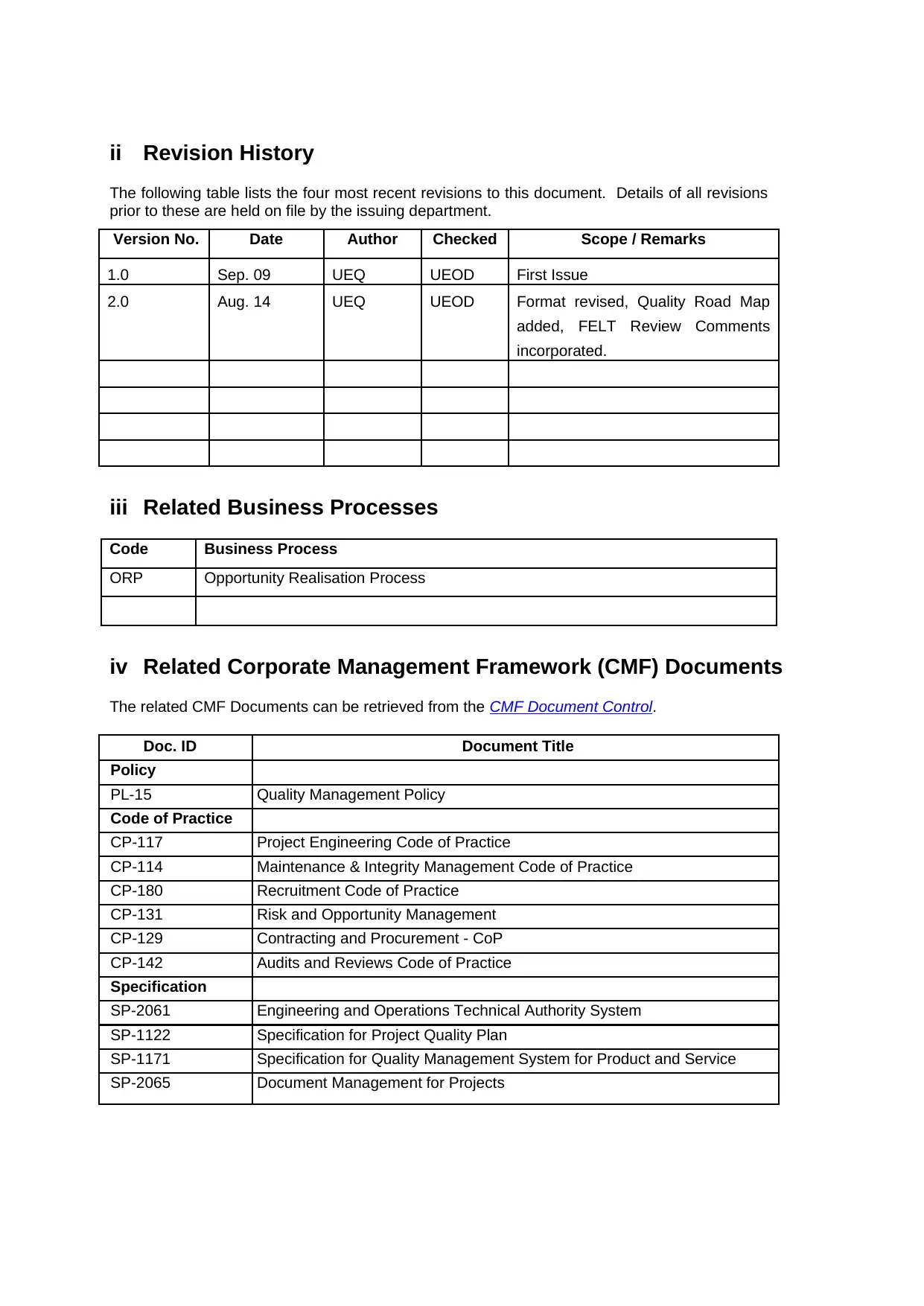
ii Revision History
The following table lists the four most recent revisions to this document. Details of all revisions
prior to these are held on file by the issuing department.
Version No. Date Author Checked Scope / Remarks
1.0 Sep. 09 UEQ UEOD First Issue
2.0 Aug. 14 UEQ UEOD Format revised, Quality Road Map
added, FELT Review Comments
incorporated.
iii Related Business Processes
Code Business Process
ORP Opportunity Realisation Process
iv Related Corporate Management Framework (CMF) Documents
The related CMF Documents can be retrieved from the CMF Document Control.
Doc. ID Document Title
Policy
PL-15 Quality Management Policy
Code of Practice
CP-117 Project Engineering Code of Practice
CP-114 Maintenance & Integrity Management Code of Practice
CP-180 Recruitment Code of Practice
CP-131 Risk and Opportunity Management
CP-129 Contracting and Procurement - CoP
CP-142 Audits and Reviews Code of Practice
Specification
SP-2061 Engineering and Operations Technical Authority System
SP-1122 Specification for Project Quality Plan
SP-1171 Specification for Quality Management System for Product and Service
SP-2065 Document Management for Projects
The following table lists the four most recent revisions to this document. Details of all revisions
prior to these are held on file by the issuing department.
Version No. Date Author Checked Scope / Remarks
1.0 Sep. 09 UEQ UEOD First Issue
2.0 Aug. 14 UEQ UEOD Format revised, Quality Road Map
added, FELT Review Comments
incorporated.
iii Related Business Processes
Code Business Process
ORP Opportunity Realisation Process
iv Related Corporate Management Framework (CMF) Documents
The related CMF Documents can be retrieved from the CMF Document Control.
Doc. ID Document Title
Policy
PL-15 Quality Management Policy
Code of Practice
CP-117 Project Engineering Code of Practice
CP-114 Maintenance & Integrity Management Code of Practice
CP-180 Recruitment Code of Practice
CP-131 Risk and Opportunity Management
CP-129 Contracting and Procurement - CoP
CP-142 Audits and Reviews Code of Practice
Specification
SP-2061 Engineering and Operations Technical Authority System
SP-1122 Specification for Project Quality Plan
SP-1171 Specification for Quality Management System for Product and Service
SP-2065 Document Management for Projects
Paraphrase This Document
Need a fresh take? Get an instant paraphrase of this document with our AI Paraphraser
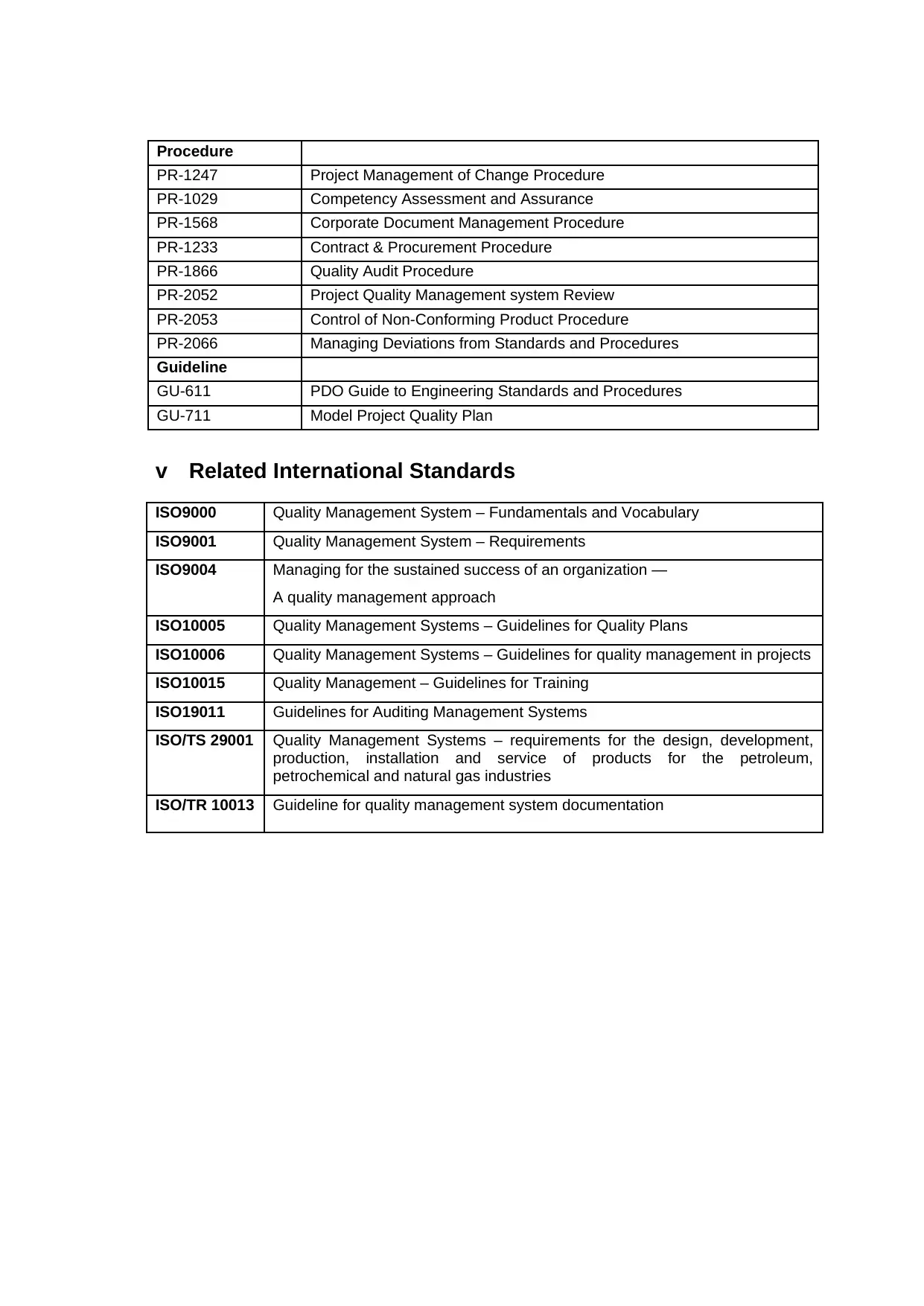
Procedure
PR-1247 Project Management of Change Procedure
PR-1029 Competency Assessment and Assurance
PR-1568 Corporate Document Management Procedure
PR-1233 Contract & Procurement Procedure
PR-1866 Quality Audit Procedure
PR-2052 Project Quality Management system Review
PR-2053 Control of Non-Conforming Product Procedure
PR-2066 Managing Deviations from Standards and Procedures
Guideline
GU-611 PDO Guide to Engineering Standards and Procedures
GU-711 Model Project Quality Plan
v Related International Standards
ISO9000 Quality Management System – Fundamentals and Vocabulary
ISO9001 Quality Management System – Requirements
ISO9004 Managing for the sustained success of an organization —
A quality management approach
ISO10005 Quality Management Systems – Guidelines for Quality Plans
ISO10006 Quality Management Systems – Guidelines for quality management in projects
ISO10015 Quality Management – Guidelines for Training
ISO19011 Guidelines for Auditing Management Systems
ISO/TS 29001 Quality Management Systems – requirements for the design, development,
production, installation and service of products for the petroleum,
petrochemical and natural gas industries
ISO/TR 10013 Guideline for quality management system documentation
PR-1247 Project Management of Change Procedure
PR-1029 Competency Assessment and Assurance
PR-1568 Corporate Document Management Procedure
PR-1233 Contract & Procurement Procedure
PR-1866 Quality Audit Procedure
PR-2052 Project Quality Management system Review
PR-2053 Control of Non-Conforming Product Procedure
PR-2066 Managing Deviations from Standards and Procedures
Guideline
GU-611 PDO Guide to Engineering Standards and Procedures
GU-711 Model Project Quality Plan
v Related International Standards
ISO9000 Quality Management System – Fundamentals and Vocabulary
ISO9001 Quality Management System – Requirements
ISO9004 Managing for the sustained success of an organization —
A quality management approach
ISO10005 Quality Management Systems – Guidelines for Quality Plans
ISO10006 Quality Management Systems – Guidelines for quality management in projects
ISO10015 Quality Management – Guidelines for Training
ISO19011 Guidelines for Auditing Management Systems
ISO/TS 29001 Quality Management Systems – requirements for the design, development,
production, installation and service of products for the petroleum,
petrochemical and natural gas industries
ISO/TR 10013 Guideline for quality management system documentation

TABLE OF CONTENTS
i Document Authorisation........................................................................................................ 3
ii Revision History.................................................................................................................... 4
iii Related Business Processes................................................................................................. 4
iv Related Corporate Management Framework (CMF) Documents..........................................4
v Related International Standards............................................................................................5
1 Introduction........................................................................................................................... 8
1.1 Background..................................................................................................................... 8
1.2 Purpose........................................................................................................................... 8
1.3 Scope.............................................................................................................................. 9
1.4 Objective.......................................................................................................................... 9
1.5 Distribution/Target Audience...........................................................................................9
1.6 Review and Improvement.............................................................................................. 10
1.7 Step-out and Approval................................................................................................... 10
1.8 Terminology, Definitions and Abbreviations...................................................................10
Term / Abbreviation.................................................................................................................... 10
Definition (or meaning for the purpose of this document)...........................................................10
2 Managing Project Quality.................................................................................................... 13
2.1 Quality Policy................................................................................................................. 13
2.1.1 PDO Corporate Quality Management Policy PL-15................................................13
2.2 Management Responsibility........................................................................................... 14
2.3 Roles and Responsibilities............................................................................................. 15
2.3.1 Head of Quality UEQ.............................................................................................. 15
2.3.2 Business Opportunity Manager (BOM) / Project Manager or Engineer (PM / PE). .15
2.3.3 Project Quality Manager/Asset Lead Quality Engineer...........................................16
2.3.4 Senior Quality Assurance Engineer........................................................................16
2.3.5 Quality Assurance Engineer....................................................................................17
2.3.6 QC Inspectors......................................................................................................... 18
2.3.7 Disciplines............................................................................................................... 18
2.4 Quality Management System Structure and Documentation Hierarchy.........................18
2.5 Quality Management Deployment Model.......................................................................19
2.6 Scaling / Application of a QMS......................................................................................19
2.7 Quality Planning............................................................................................................. 21
2.8 Resource Management................................................................................................. 27
2.9 Quality Training.............................................................................................................. 28
2.10 3rd Party Inspection Agencies.......................................................................................28
2.11 Measurement, Analysis and Improvement.....................................................................29
2.12 Audits & Reviews........................................................................................................... 29
i Document Authorisation........................................................................................................ 3
ii Revision History.................................................................................................................... 4
iii Related Business Processes................................................................................................. 4
iv Related Corporate Management Framework (CMF) Documents..........................................4
v Related International Standards............................................................................................5
1 Introduction........................................................................................................................... 8
1.1 Background..................................................................................................................... 8
1.2 Purpose........................................................................................................................... 8
1.3 Scope.............................................................................................................................. 9
1.4 Objective.......................................................................................................................... 9
1.5 Distribution/Target Audience...........................................................................................9
1.6 Review and Improvement.............................................................................................. 10
1.7 Step-out and Approval................................................................................................... 10
1.8 Terminology, Definitions and Abbreviations...................................................................10
Term / Abbreviation.................................................................................................................... 10
Definition (or meaning for the purpose of this document)...........................................................10
2 Managing Project Quality.................................................................................................... 13
2.1 Quality Policy................................................................................................................. 13
2.1.1 PDO Corporate Quality Management Policy PL-15................................................13
2.2 Management Responsibility........................................................................................... 14
2.3 Roles and Responsibilities............................................................................................. 15
2.3.1 Head of Quality UEQ.............................................................................................. 15
2.3.2 Business Opportunity Manager (BOM) / Project Manager or Engineer (PM / PE). .15
2.3.3 Project Quality Manager/Asset Lead Quality Engineer...........................................16
2.3.4 Senior Quality Assurance Engineer........................................................................16
2.3.5 Quality Assurance Engineer....................................................................................17
2.3.6 QC Inspectors......................................................................................................... 18
2.3.7 Disciplines............................................................................................................... 18
2.4 Quality Management System Structure and Documentation Hierarchy.........................18
2.5 Quality Management Deployment Model.......................................................................19
2.6 Scaling / Application of a QMS......................................................................................19
2.7 Quality Planning............................................................................................................. 21
2.8 Resource Management................................................................................................. 27
2.9 Quality Training.............................................................................................................. 28
2.10 3rd Party Inspection Agencies.......................................................................................28
2.11 Measurement, Analysis and Improvement.....................................................................29
2.12 Audits & Reviews........................................................................................................... 29
⊘ This is a preview!⊘
Do you want full access?
Subscribe today to unlock all pages.

Trusted by 1+ million students worldwide
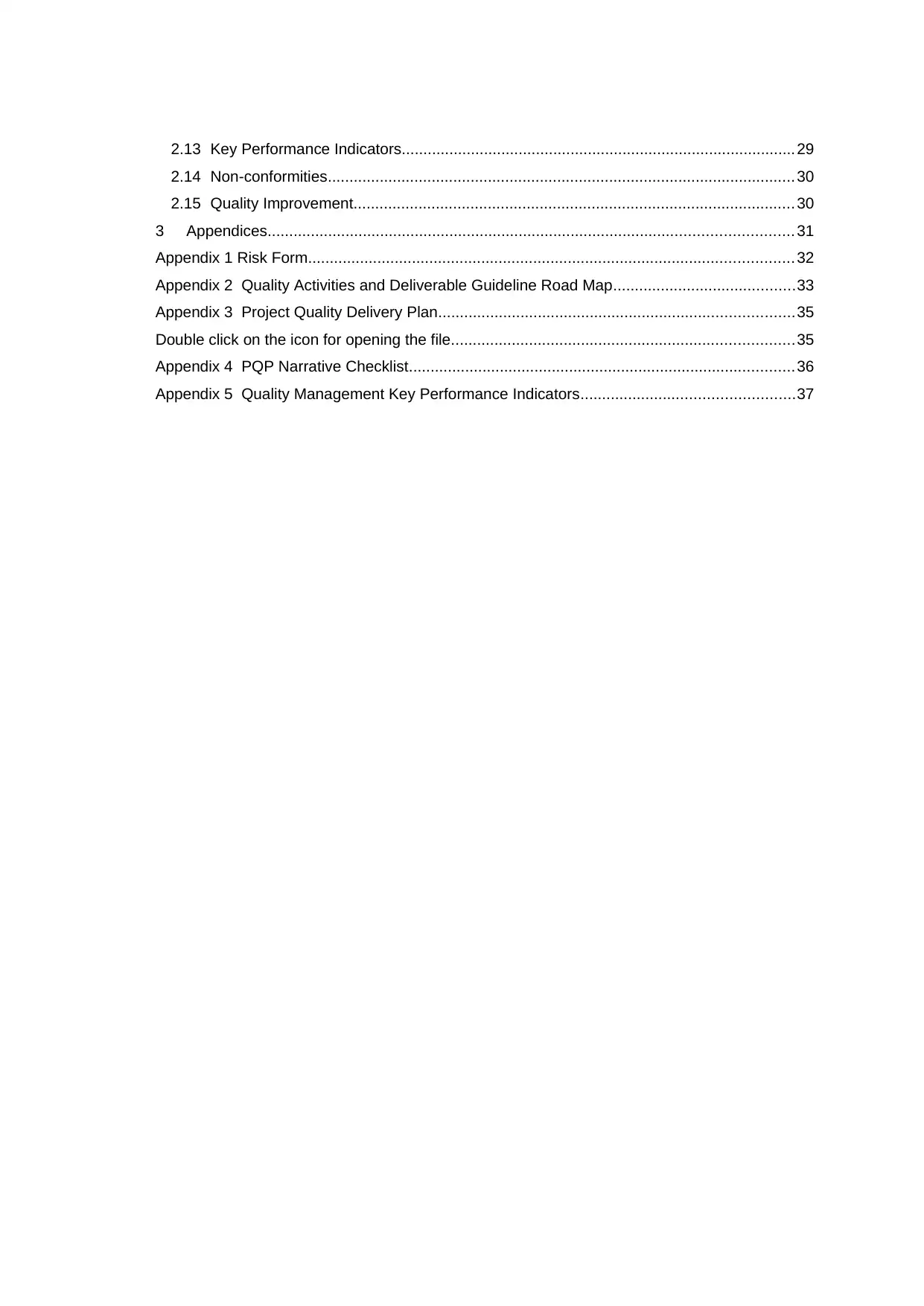
2.13 Key Performance Indicators........................................................................................... 29
2.14 Non-conformities............................................................................................................ 30
2.15 Quality Improvement...................................................................................................... 30
3 Appendices......................................................................................................................... 31
Appendix 1 Risk Form................................................................................................................ 32
Appendix 2 Quality Activities and Deliverable Guideline Road Map..........................................33
Appendix 3 Project Quality Delivery Plan..................................................................................35
Double click on the icon for opening the file...............................................................................35
Appendix 4 PQP Narrative Checklist.........................................................................................36
Appendix 5 Quality Management Key Performance Indicators.................................................37
2.14 Non-conformities............................................................................................................ 30
2.15 Quality Improvement...................................................................................................... 30
3 Appendices......................................................................................................................... 31
Appendix 1 Risk Form................................................................................................................ 32
Appendix 2 Quality Activities and Deliverable Guideline Road Map..........................................33
Appendix 3 Project Quality Delivery Plan..................................................................................35
Double click on the icon for opening the file...............................................................................35
Appendix 4 PQP Narrative Checklist.........................................................................................36
Appendix 5 Quality Management Key Performance Indicators.................................................37
Paraphrase This Document
Need a fresh take? Get an instant paraphrase of this document with our AI Paraphraser
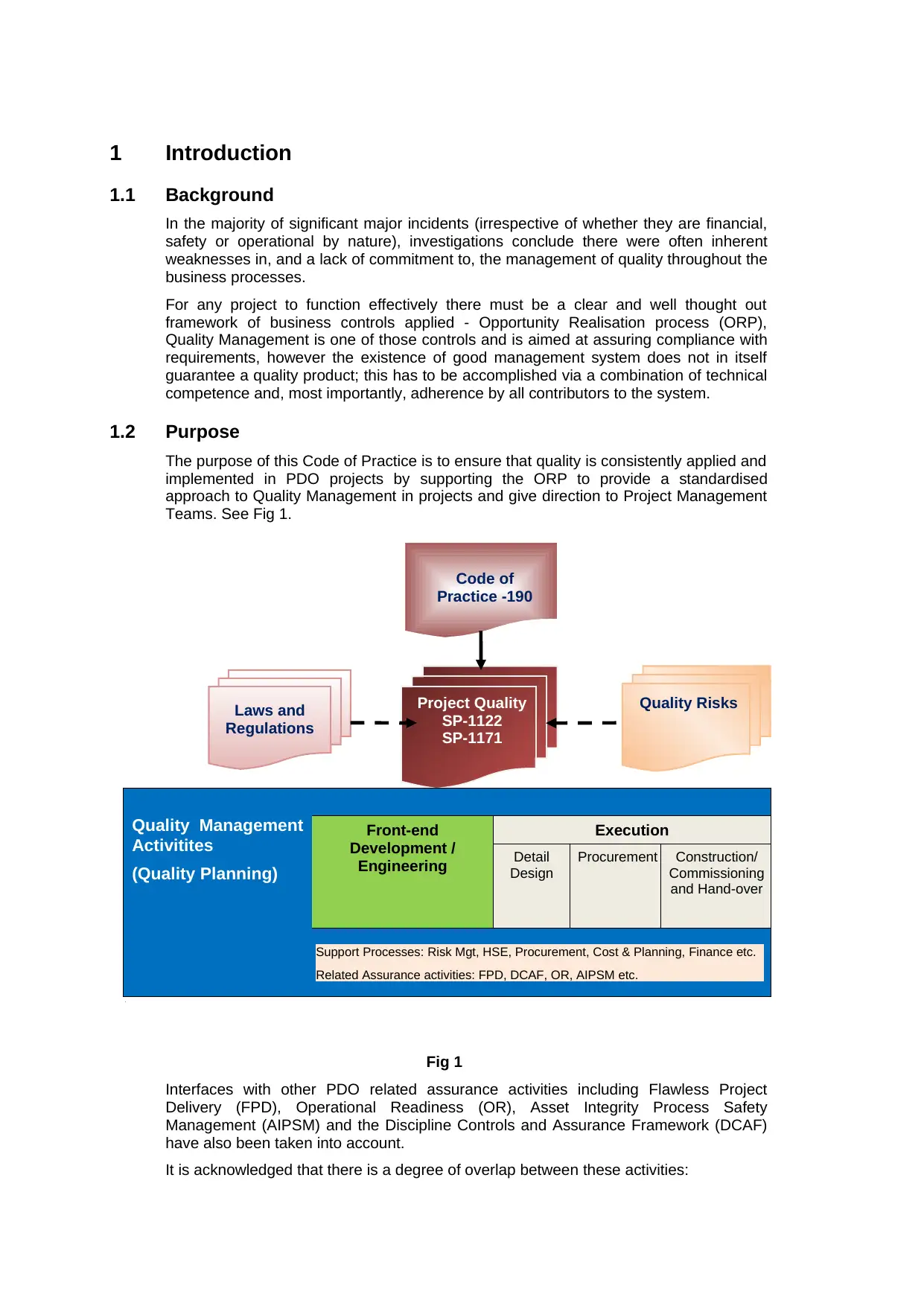
Code of
Practice -190
Laws and
Regulations
Project Quality
SP-1122
SP-1171
Quality Risks
1 Introduction
1.1 Background
In the majority of significant major incidents (irrespective of whether they are financial,
safety or operational by nature), investigations conclude there were often inherent
weaknesses in, and a lack of commitment to, the management of quality throughout the
business processes.
For any project to function effectively there must be a clear and well thought out
framework of business controls applied - Opportunity Realisation process (ORP),
Quality Management is one of those controls and is aimed at assuring compliance with
requirements, however the existence of good management system does not in itself
guarantee a quality product; this has to be accomplished via a combination of technical
competence and, most importantly, adherence by all contributors to the system.
1.2 Purpose
The purpose of this Code of Practice is to ensure that quality is consistently applied and
implemented in PDO projects by supporting the ORP to provide a standardised
approach to Quality Management in projects and give direction to Project Management
Teams. See Fig 1.
Quality Management
Activitites
(Quality Planning)
Front-end
Development /
Engineering
Execution
Detail
Design
Procurement Construction/
Commissioning
and Hand-over
Fig 1
Interfaces with other PDO related assurance activities including Flawless Project
Delivery (FPD), Operational Readiness (OR), Asset Integrity Process Safety
Management (AIPSM) and the Discipline Controls and Assurance Framework (DCAF)
have also been taken into account.
It is acknowledged that there is a degree of overlap between these activities:
IdentifyAssessSelectDefineExecuteOperateSupport Processes: Risk Mgt, HSE, Procurement, Cost & Planning, Finance etc.
Related Assurance activities: FPD, DCAF, OR, AIPSM etc.
Practice -190
Laws and
Regulations
Project Quality
SP-1122
SP-1171
Quality Risks
1 Introduction
1.1 Background
In the majority of significant major incidents (irrespective of whether they are financial,
safety or operational by nature), investigations conclude there were often inherent
weaknesses in, and a lack of commitment to, the management of quality throughout the
business processes.
For any project to function effectively there must be a clear and well thought out
framework of business controls applied - Opportunity Realisation process (ORP),
Quality Management is one of those controls and is aimed at assuring compliance with
requirements, however the existence of good management system does not in itself
guarantee a quality product; this has to be accomplished via a combination of technical
competence and, most importantly, adherence by all contributors to the system.
1.2 Purpose
The purpose of this Code of Practice is to ensure that quality is consistently applied and
implemented in PDO projects by supporting the ORP to provide a standardised
approach to Quality Management in projects and give direction to Project Management
Teams. See Fig 1.
Quality Management
Activitites
(Quality Planning)
Front-end
Development /
Engineering
Execution
Detail
Design
Procurement Construction/
Commissioning
and Hand-over
Fig 1
Interfaces with other PDO related assurance activities including Flawless Project
Delivery (FPD), Operational Readiness (OR), Asset Integrity Process Safety
Management (AIPSM) and the Discipline Controls and Assurance Framework (DCAF)
have also been taken into account.
It is acknowledged that there is a degree of overlap between these activities:
IdentifyAssessSelectDefineExecuteOperateSupport Processes: Risk Mgt, HSE, Procurement, Cost & Planning, Finance etc.
Related Assurance activities: FPD, DCAF, OR, AIPSM etc.
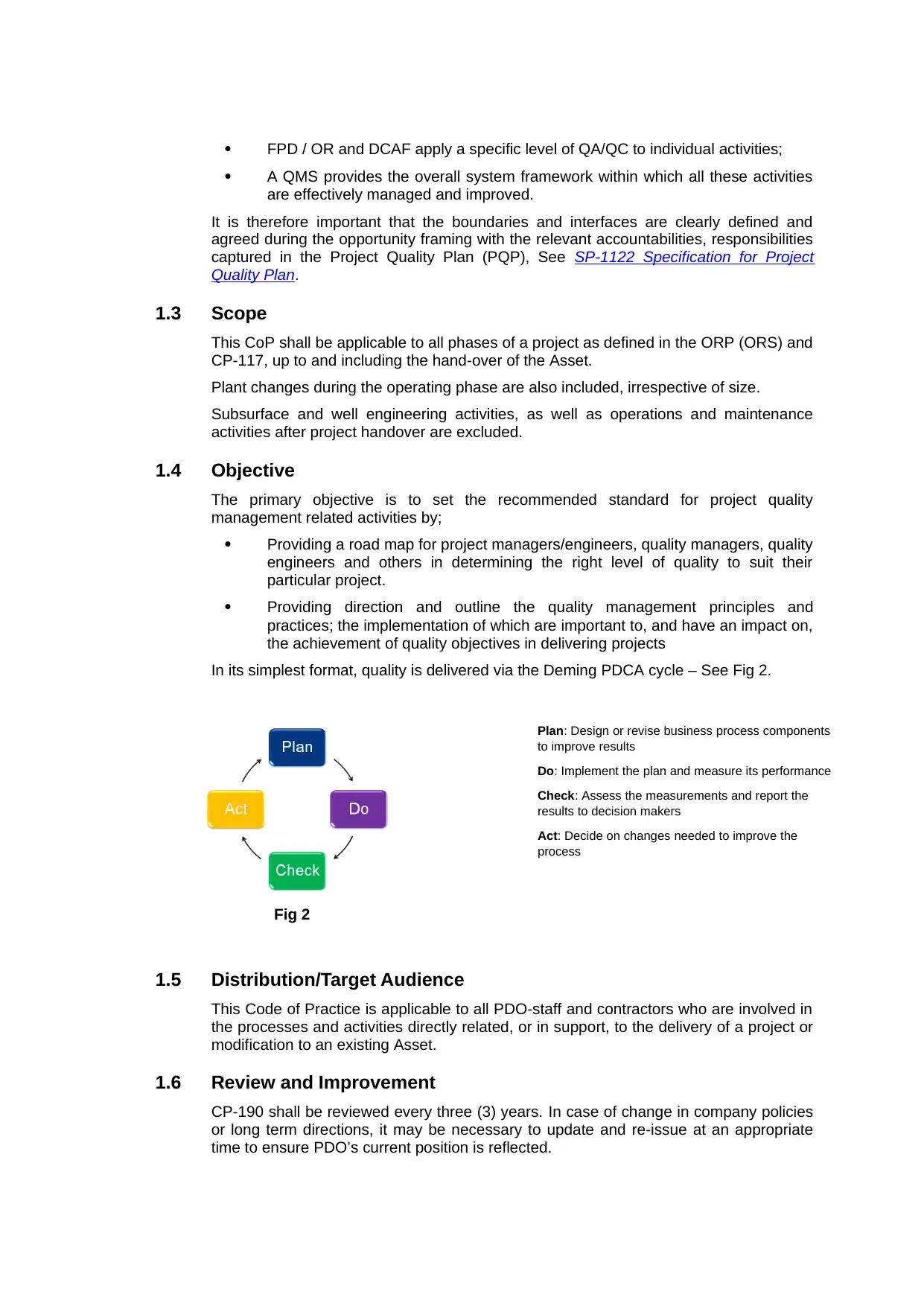
FPD / OR and DCAF apply a specific level of QA/QC to individual activities;
A QMS provides the overall system framework within which all these activities
are effectively managed and improved.
It is therefore important that the boundaries and interfaces are clearly defined and
agreed during the opportunity framing with the relevant accountabilities, responsibilities
captured in the Project Quality Plan (PQP), See SP-1122 Specification for Project
Quality Plan.
1.3 Scope
This CoP shall be applicable to all phases of a project as defined in the ORP (ORS) and
CP-117, up to and including the hand-over of the Asset.
Plant changes during the operating phase are also included, irrespective of size.
Subsurface and well engineering activities, as well as operations and maintenance
activities after project handover are excluded.
1.4 Objective
The primary objective is to set the recommended standard for project quality
management related activities by;
Providing a road map for project managers/engineers, quality managers, quality
engineers and others in determining the right level of quality to suit their
particular project.
Providing direction and outline the quality management principles and
practices; the implementation of which are important to, and have an impact on,
the achievement of quality objectives in delivering projects
In its simplest format, quality is delivered via the Deming PDCA cycle – See Fig 2.
Fig 2
1.5 Distribution/Target Audience
This Code of Practice is applicable to all PDO-staff and contractors who are involved in
the processes and activities directly related, or in support, to the delivery of a project or
modification to an existing Asset.
1.6 Review and Improvement
CP-190 shall be reviewed every three (3) years. In case of change in company policies
or long term directions, it may be necessary to update and re-issue at an appropriate
time to ensure PDO’s current position is reflected.
Plan: Design or revise business process components
to improve results
Do: Implement the plan and measure its performance
Check: Assess the measurements and report the
results to decision makers
Act: Decide on changes needed to improve the
process
A QMS provides the overall system framework within which all these activities
are effectively managed and improved.
It is therefore important that the boundaries and interfaces are clearly defined and
agreed during the opportunity framing with the relevant accountabilities, responsibilities
captured in the Project Quality Plan (PQP), See SP-1122 Specification for Project
Quality Plan.
1.3 Scope
This CoP shall be applicable to all phases of a project as defined in the ORP (ORS) and
CP-117, up to and including the hand-over of the Asset.
Plant changes during the operating phase are also included, irrespective of size.
Subsurface and well engineering activities, as well as operations and maintenance
activities after project handover are excluded.
1.4 Objective
The primary objective is to set the recommended standard for project quality
management related activities by;
Providing a road map for project managers/engineers, quality managers, quality
engineers and others in determining the right level of quality to suit their
particular project.
Providing direction and outline the quality management principles and
practices; the implementation of which are important to, and have an impact on,
the achievement of quality objectives in delivering projects
In its simplest format, quality is delivered via the Deming PDCA cycle – See Fig 2.
Fig 2
1.5 Distribution/Target Audience
This Code of Practice is applicable to all PDO-staff and contractors who are involved in
the processes and activities directly related, or in support, to the delivery of a project or
modification to an existing Asset.
1.6 Review and Improvement
CP-190 shall be reviewed every three (3) years. In case of change in company policies
or long term directions, it may be necessary to update and re-issue at an appropriate
time to ensure PDO’s current position is reflected.
Plan: Design or revise business process components
to improve results
Do: Implement the plan and measure its performance
Check: Assess the measurements and report the
results to decision makers
Act: Decide on changes needed to improve the
process
⊘ This is a preview!⊘
Do you want full access?
Subscribe today to unlock all pages.

Trusted by 1+ million students worldwide

1.7 Step-out and Approval
Any changes that need to be made to this Code of Practice shall be forwarded to the
Corporate Functional Discipline Head (CFDH) for Quality Management UEQ, See PR-
1247 Project Management of Change Procedure and PR-2066 Managing Deviations
from Standards and Procedures.
1.8 Terminology, Definitions and Abbreviations
Table 1 below lists the terminologies, definitions and abbreviations used throughout the
text of this document, wherever the term ‘project’ occurs, it may also mean ‘opportunity’.
Throughout this document the term Quality Management System (QMS) is used to
describe the Quality System through which QM is implemented.
This CoP uses “Shall” , “Should” and “May” in the following context:
“Shall” indicates a mandatory requirement and dispensation can only be granted by the
relevant authority. “Should” indicates a recommendation and “May” indicates a possible
course of action and is optional.
Table 1
Term /
Abbreviation
Definition (or meaning for the purpose of this document)
Accountability Being liable for certain actions to be taken and results achieved.
Accountability = Responsibility + Authority.
AI-PSM Asset Integrity Process Safety Management.
Audit
Systematic, independent and documented process for obtaining audit
evidence and evaluating it objectively to determine the extent to which audit
criteria are fulfilled.
BMS
Business Management System. A set of policies, practices, processes &
procedures used in developing strategies, their execution and all associated
management activities.
BOM Business Opportunity Manager.
BFD Basis for Design.
CFDH Corporate Functional Department Head.
Change
A planned action to revise: a rule, procedure, standard, process, hardware
(including equipment and plant configuration) or organization. The approval of
a change must be obtained in advance of its implementation.
CMF Corporate Management Framework.
Company Petroleum Development Oman.
Contractor A third party (person, company, joint venture) employed to complete a specific
task on behalf of the Company.
CCMS Project Completions Management System.
CoP Code of Practice.
CQP Contract Quality Plan.
CSR Company Site Representative.
DCAF Discipline Control Assurance Framework.
DE Decision Executive
Deviation
A proactive and planned intentional or approved non-compliance with
mandatory requirements of a procedure, standard or specification. The
justification shall be submitted for review and approval obtained from an
appropriate technical authority prior to the deviation taking effect. A deviation
can be temporary, but will often be permanent for a specific installation.
Any changes that need to be made to this Code of Practice shall be forwarded to the
Corporate Functional Discipline Head (CFDH) for Quality Management UEQ, See PR-
1247 Project Management of Change Procedure and PR-2066 Managing Deviations
from Standards and Procedures.
1.8 Terminology, Definitions and Abbreviations
Table 1 below lists the terminologies, definitions and abbreviations used throughout the
text of this document, wherever the term ‘project’ occurs, it may also mean ‘opportunity’.
Throughout this document the term Quality Management System (QMS) is used to
describe the Quality System through which QM is implemented.
This CoP uses “Shall” , “Should” and “May” in the following context:
“Shall” indicates a mandatory requirement and dispensation can only be granted by the
relevant authority. “Should” indicates a recommendation and “May” indicates a possible
course of action and is optional.
Table 1
Term /
Abbreviation
Definition (or meaning for the purpose of this document)
Accountability Being liable for certain actions to be taken and results achieved.
Accountability = Responsibility + Authority.
AI-PSM Asset Integrity Process Safety Management.
Audit
Systematic, independent and documented process for obtaining audit
evidence and evaluating it objectively to determine the extent to which audit
criteria are fulfilled.
BMS
Business Management System. A set of policies, practices, processes &
procedures used in developing strategies, their execution and all associated
management activities.
BOM Business Opportunity Manager.
BFD Basis for Design.
CFDH Corporate Functional Department Head.
Change
A planned action to revise: a rule, procedure, standard, process, hardware
(including equipment and plant configuration) or organization. The approval of
a change must be obtained in advance of its implementation.
CMF Corporate Management Framework.
Company Petroleum Development Oman.
Contractor A third party (person, company, joint venture) employed to complete a specific
task on behalf of the Company.
CCMS Project Completions Management System.
CoP Code of Practice.
CQP Contract Quality Plan.
CSR Company Site Representative.
DCAF Discipline Control Assurance Framework.
DE Decision Executive
Deviation
A proactive and planned intentional or approved non-compliance with
mandatory requirements of a procedure, standard or specification. The
justification shall be submitted for review and approval obtained from an
appropriate technical authority prior to the deviation taking effect. A deviation
can be temporary, but will often be permanent for a specific installation.
Paraphrase This Document
Need a fresh take? Get an instant paraphrase of this document with our AI Paraphraser
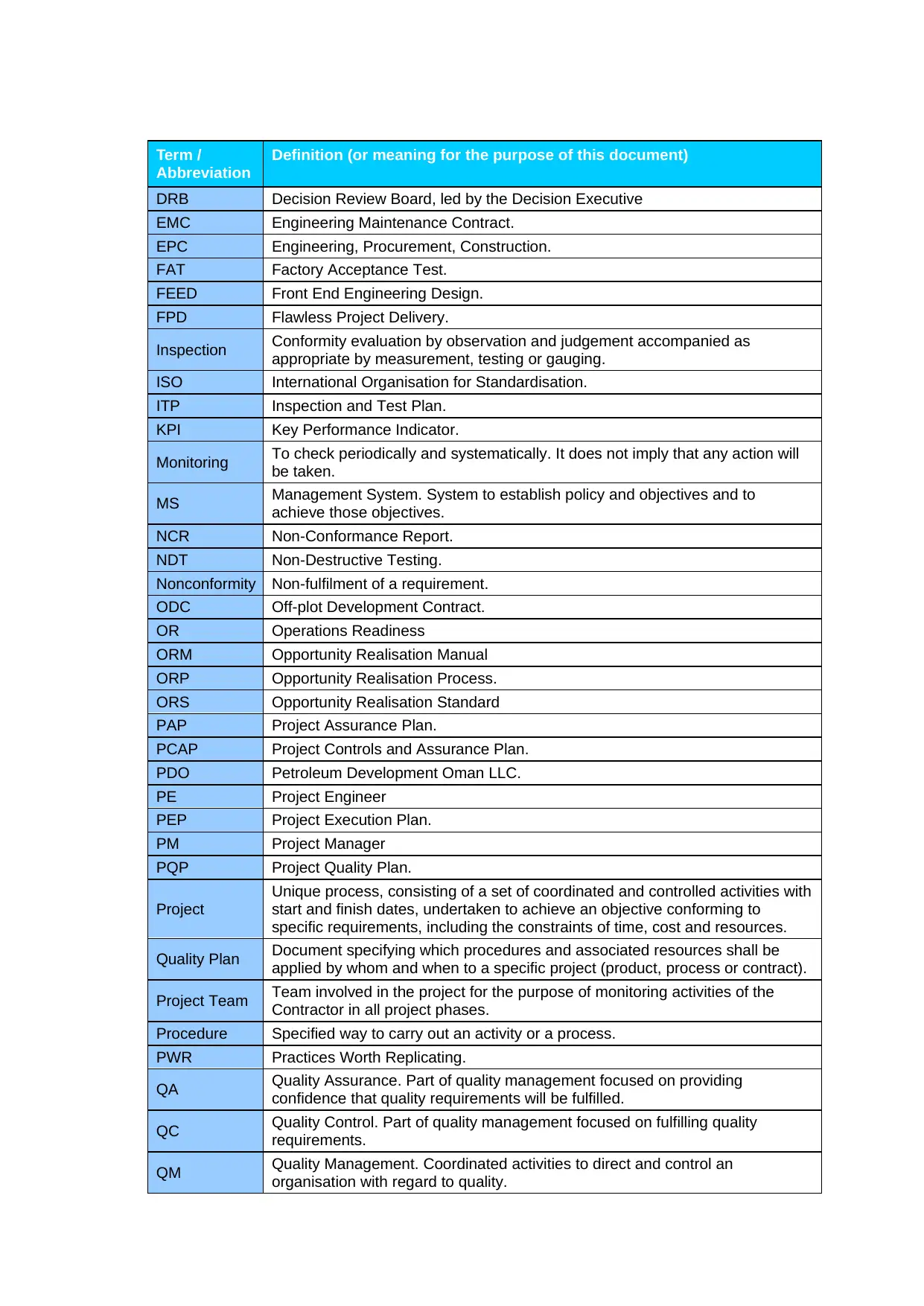
Term /
Abbreviation
Definition (or meaning for the purpose of this document)
DRB Decision Review Board, led by the Decision Executive
EMC Engineering Maintenance Contract.
EPC Engineering, Procurement, Construction.
FAT Factory Acceptance Test.
FEED Front End Engineering Design.
FPD Flawless Project Delivery.
Inspection Conformity evaluation by observation and judgement accompanied as
appropriate by measurement, testing or gauging.
ISO International Organisation for Standardisation.
ITP Inspection and Test Plan.
KPI Key Performance Indicator.
Monitoring To check periodically and systematically. It does not imply that any action will
be taken.
MS Management System. System to establish policy and objectives and to
achieve those objectives.
NCR Non-Conformance Report.
NDT Non-Destructive Testing.
Nonconformity Non-fulfilment of a requirement.
ODC Off-plot Development Contract.
OR Operations Readiness
ORM Opportunity Realisation Manual
ORP Opportunity Realisation Process.
ORS Opportunity Realisation Standard
PAP Project Assurance Plan.
PCAP Project Controls and Assurance Plan.
PDO Petroleum Development Oman LLC.
PE Project Engineer
PEP Project Execution Plan.
PM Project Manager
PQP Project Quality Plan.
Project
Unique process, consisting of a set of coordinated and controlled activities with
start and finish dates, undertaken to achieve an objective conforming to
specific requirements, including the constraints of time, cost and resources.
Quality Plan Document specifying which procedures and associated resources shall be
applied by whom and when to a specific project (product, process or contract).
Project Team Team involved in the project for the purpose of monitoring activities of the
Contractor in all project phases.
Procedure Specified way to carry out an activity or a process.
PWR Practices Worth Replicating.
QA Quality Assurance. Part of quality management focused on providing
confidence that quality requirements will be fulfilled.
QC Quality Control. Part of quality management focused on fulfilling quality
requirements.
QM Quality Management. Coordinated activities to direct and control an
organisation with regard to quality.
Abbreviation
Definition (or meaning for the purpose of this document)
DRB Decision Review Board, led by the Decision Executive
EMC Engineering Maintenance Contract.
EPC Engineering, Procurement, Construction.
FAT Factory Acceptance Test.
FEED Front End Engineering Design.
FPD Flawless Project Delivery.
Inspection Conformity evaluation by observation and judgement accompanied as
appropriate by measurement, testing or gauging.
ISO International Organisation for Standardisation.
ITP Inspection and Test Plan.
KPI Key Performance Indicator.
Monitoring To check periodically and systematically. It does not imply that any action will
be taken.
MS Management System. System to establish policy and objectives and to
achieve those objectives.
NCR Non-Conformance Report.
NDT Non-Destructive Testing.
Nonconformity Non-fulfilment of a requirement.
ODC Off-plot Development Contract.
OR Operations Readiness
ORM Opportunity Realisation Manual
ORP Opportunity Realisation Process.
ORS Opportunity Realisation Standard
PAP Project Assurance Plan.
PCAP Project Controls and Assurance Plan.
PDO Petroleum Development Oman LLC.
PE Project Engineer
PEP Project Execution Plan.
PM Project Manager
PQP Project Quality Plan.
Project
Unique process, consisting of a set of coordinated and controlled activities with
start and finish dates, undertaken to achieve an objective conforming to
specific requirements, including the constraints of time, cost and resources.
Quality Plan Document specifying which procedures and associated resources shall be
applied by whom and when to a specific project (product, process or contract).
Project Team Team involved in the project for the purpose of monitoring activities of the
Contractor in all project phases.
Procedure Specified way to carry out an activity or a process.
PWR Practices Worth Replicating.
QA Quality Assurance. Part of quality management focused on providing
confidence that quality requirements will be fulfilled.
QC Quality Control. Part of quality management focused on fulfilling quality
requirements.
QM Quality Management. Coordinated activities to direct and control an
organisation with regard to quality.
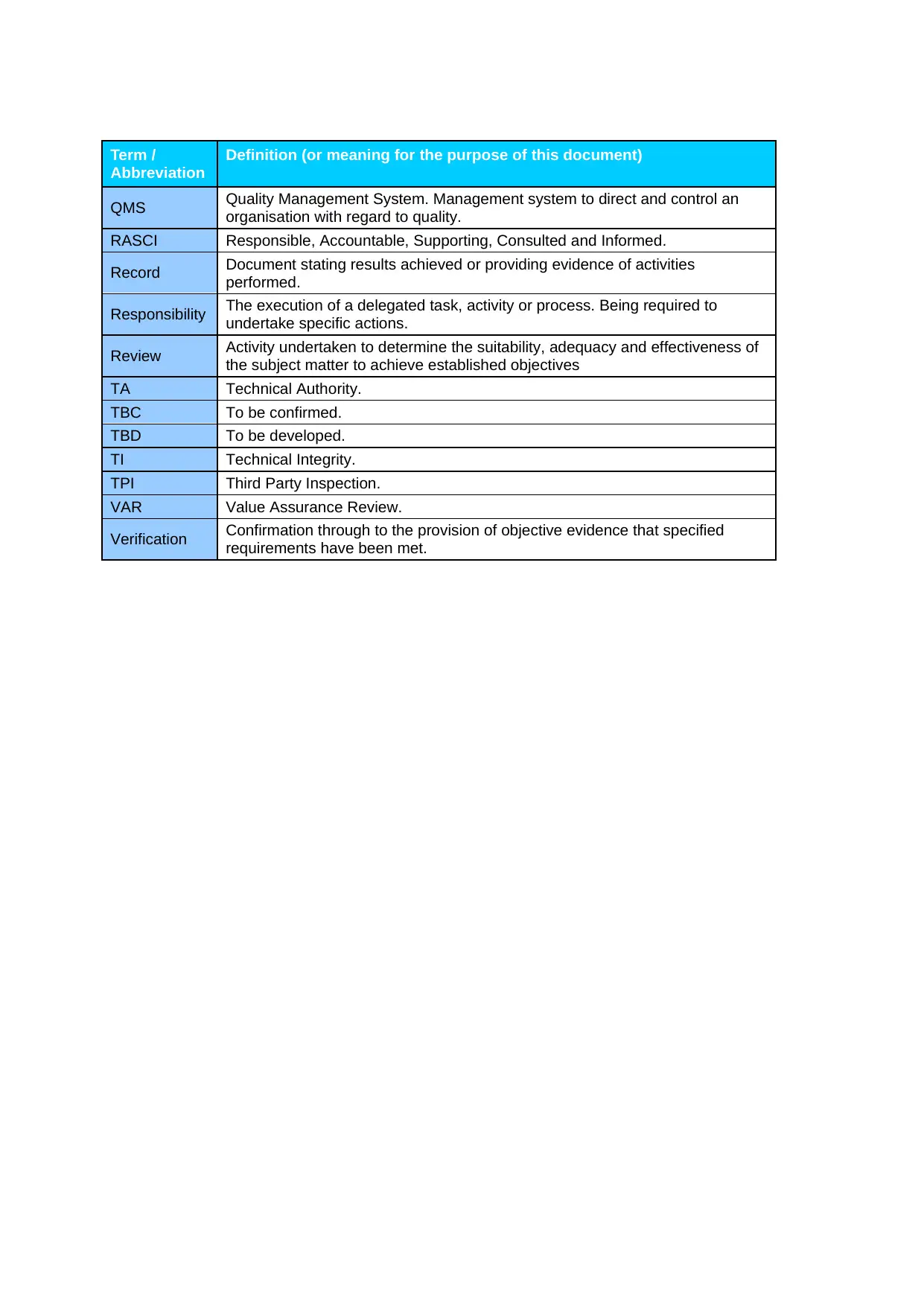
Term /
Abbreviation
Definition (or meaning for the purpose of this document)
QMS Quality Management System. Management system to direct and control an
organisation with regard to quality.
RASCI Responsible, Accountable, Supporting, Consulted and Informed.
Record Document stating results achieved or providing evidence of activities
performed.
Responsibility The execution of a delegated task, activity or process. Being required to
undertake specific actions.
Review Activity undertaken to determine the suitability, adequacy and effectiveness of
the subject matter to achieve established objectives
TA Technical Authority.
TBC To be confirmed.
TBD To be developed.
TI Technical Integrity.
TPI Third Party Inspection.
VAR Value Assurance Review.
Verification Confirmation through to the provision of objective evidence that specified
requirements have been met.
Abbreviation
Definition (or meaning for the purpose of this document)
QMS Quality Management System. Management system to direct and control an
organisation with regard to quality.
RASCI Responsible, Accountable, Supporting, Consulted and Informed.
Record Document stating results achieved or providing evidence of activities
performed.
Responsibility The execution of a delegated task, activity or process. Being required to
undertake specific actions.
Review Activity undertaken to determine the suitability, adequacy and effectiveness of
the subject matter to achieve established objectives
TA Technical Authority.
TBC To be confirmed.
TBD To be developed.
TI Technical Integrity.
TPI Third Party Inspection.
VAR Value Assurance Review.
Verification Confirmation through to the provision of objective evidence that specified
requirements have been met.
⊘ This is a preview!⊘
Do you want full access?
Subscribe today to unlock all pages.

Trusted by 1+ million students worldwide
1 out of 39
Your All-in-One AI-Powered Toolkit for Academic Success.
+13062052269
info@desklib.com
Available 24*7 on WhatsApp / Email
![[object Object]](/_next/static/media/star-bottom.7253800d.svg)
Unlock your academic potential
Copyright © 2020–2025 A2Z Services. All Rights Reserved. Developed and managed by ZUCOL.

